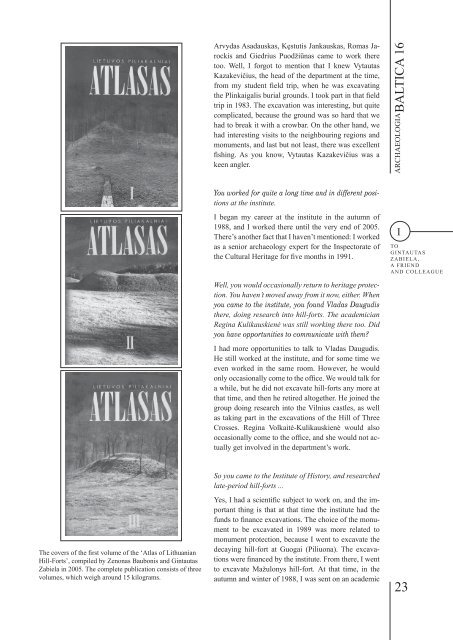BALTICA16 - Klaipėdos universitetas
BALTICA16 - Klaipėdos universitetas
BALTICA16 - Klaipėdos universitetas
Create successful ePaper yourself
Turn your PDF publications into a flip-book with our unique Google optimized e-Paper software.
The covers of the first volume of the ‘Atlas of Lithuanian<br />
Hill-Forts’, compiled by Zenonas Baubonis and Gintautas<br />
Zabiela in 2005. The complete publication consists of three<br />
volumes, which weigh around 15 kilograms.<br />
Arvydas Asadauskas, Kęstutis Jankauskas, Romas Jarockis<br />
and Giedrius Puodžiūnas came to work there<br />
too. Well, I forgot to mention that I knew Vytautas<br />
Kazakevičius, the head of the department at the time,<br />
from my student field trip, when he was excavating<br />
the Plinkaigalis burial grounds. I took part in that field<br />
trip in 1983. The excavation was interesting, but quite<br />
complicated, because the ground was so hard that we<br />
had to break it with a crowbar. On the other hand, we<br />
had interesting visits to the neighbouring regions and<br />
monuments, and last but not least, there was excellent<br />
fishing. As you know, Vytautas Kazakevičius was a<br />
keen angler.<br />
You worked for quite a long time and in different positions<br />
at the institute.<br />
I began my career at the institute in the autumn of<br />
1988, and I worked there until the very end of 2005.<br />
There’s another fact that I haven’t mentioned: I worked<br />
as a senior archaeology expert for the Inspectorate of<br />
the Cultural Heritage for five months in 1991.<br />
Well, you would occasionally return to heritage protection.<br />
You haven’t moved away from it now, either. When<br />
you came to the institute, you found Vladas Daugudis<br />
there, doing research into hill-forts. The academician<br />
Regina Kulikauskienė was still working there too. Did<br />
you have opportunities to communicate with them?<br />
I had more opportunities to talk to Vladas Daugudis.<br />
He still worked at the institute, and for some time we<br />
even worked in the same room. However, he would<br />
only occasionally come to the office. We would talk for<br />
a while, but he did not excavate hill-forts any more at<br />
that time, and then he retired altogether. He joined the<br />
group doing research into the Vilnius castles, as well<br />
as taking part in the excavations of the Hill of Three<br />
Crosses. Regina Volkaitė-Kulikauskienė would also<br />
occasionally come to the office, and she would not actually<br />
get involved in the department’s work.<br />
So you came to the Institute of History, and researched<br />
late-period hill-forts ...<br />
Yes, I had a scientific subject to work on, and the important<br />
thing is that at that time the institute had the<br />
funds to finance excavations. The choice of the monument<br />
to be excavated in 1989 was more related to<br />
monument protection, because I went to excavate the<br />
decaying hill-fort at Guogai (Piliuona). The excavations<br />
were financed by the institute. From there, I went<br />
to excavate Mažulonys hill-fort. At that time, in the<br />
autumn and winter of 1988, I was sent on an academic<br />
ARCHAEOLOGIA BALTICA 16<br />
I<br />
TO<br />
GINTAUTAS<br />
ZABIELA,<br />
A FRIEND<br />
AND COLLEAGUE<br />
23

















